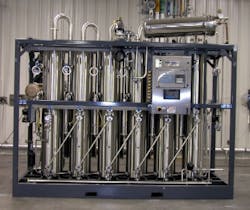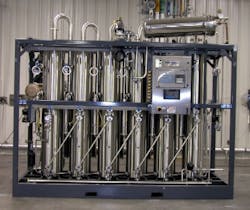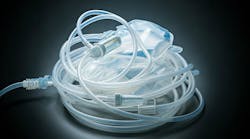By Paul Thomas, Managing Editor
Amgen is bullish on Puerto Rico. It has added bulk manufacturing to its facilities in Juncos the companys only commercial fill-and-finish site three times since 2000 to expand operations of its most successful products, including Epogen, Neupogen and Enbrel.Expanding facilities require expanding water capabilities. The most recent $400 million, 500,000-square-foot expansion included the design and implementation of a new Water-for-Injection (WFI) system, with USP-grade water processed by a high-capacity multiple-effect still. The company is in the process of validating the new lines and ramping up production.Amgen lead process engineer Pete Jarvis, and Tony Cope, a process engineer and utility systems expert with Fluor Corp., headed up the WFI project. Jarvis has worked with Amgen in Puerto Rico for four years, and for six years previously in Boulder, Colo. The two worked with equipment provider Paul Mueller Co. (Springfield, Mo.) to specify still capacities and options, then designed the distribution system and assisted in start-up. Design included pumping systems including back-pressure and pump controls, heat exchangers, subloops and extensive troubleshooting.In this article, Jarvis and Cope share lessons learned in Juncos and WFI best practices based upon their years of expertise.WFI for processingAmgen in Juncos uses WFI for most of its process or product-contact water, Jarvis and Cope say, including cell culture media preparation, sink drops, glass washer final rinses, and even the final rinse of equipment cleaning. This requires a WFI output of thousands of liters per hour. Lower-grade RO (Reverse Osmosis) water is used for the early stages of Clean-in-Place.I have worked for other plants, such as Amgen in Colorado or the Neupogen facility in Juncos, where we didnt use WFI for all of the process water, Jarvis says. For the upstream operations, we just used RO water to make media for a fermenter, for example. Amgen decided to take the conservative approach and use WFI for all cell culture processes in Juncos to ensure that water purity would not be an issue and hamper start-up of expanded operations.A new wrinkle tested at Juncos was to collect the WFI of the final CIP rinse and reuse it as the first prerinse of the subsequent CIP cycle for different equipment. This is a key water conservation step, Jarvis says, and is not altogether uncommon in the industry. If its not already, this is starting to become standard practice in the industry, Jarvis says. As long as the step is validated, It makes sense if you can recover a rather large volume of water and reuse it, adds Cope.Because of the conservative approach, WFI validation proceeded smoothly, though there was one hitch, Cope recalls. We started validation while we were at the tail end of construction, so it made it difficult to get a passing sample, Cope says. We would get debris in the samples, or TOC [total organic carbon] presumably from paint fumes or cleaning fluids, and it delayed validation a bit. In one area of the plant, we started gowning and cleaning sooner than planned so that we wouldnt contaminate our WFI samples.Ive been on a lot of projects where weve had to sample WFI during construction, and weve had to make sure we take the right measures, Jarvis adds. You have to think it through carefully. You have to figure out how youre going to get a good sample how to protect them and how to schedule them.Still lifeAmgen chose the Paul Mueller multiple-effect still after a competitive bidding process. Multiple-effect and vapor recompression are Amgens two approved methods for water purification. Amgens new standard is vapor recompression, Jarvis says, since the systems can process greater amounts of water for a lower operating cost. Vapor recompression requires much less plant steam than multiple-effect and no cooling water if it is stored hot, though it also uses more electricity and can lose its cost-saving advantage if local electricity rates are high. For larger capacity requirements, vapor recompression units also require less floor space than WFI stills.As biopharmaceutical processes and WFI needs expand, vapor recompression becomes more of the industry standard as well. But Amgen evaluates both technologies for each project. In Puerto Rico, multiple-effect WFI made sense. Amgens team discovered that the islands water has large amounts of silica, which would require extensive pretreatment for a vapor recompression system. Recompression becomes a lot more economical if you can forego some of the pretreatment and use a lower-quality water, Cope explains, but the silica level here is so high that it will scale the unit, so you have to send it through an RO anyway.
Amgen is bullish on Puerto Rico. It has added bulk manufacturing to its facilities in Juncos the companys only commercial fill-and-finish site three times since 2000 to expand operations of its most successful products, including Epogen, Neupogen and Enbrel.Expanding facilities require expanding water capabilities. The most recent $400 million, 500,000-square-foot expansion included the design and implementation of a new Water-for-Injection (WFI) system, with USP-grade water processed by a high-capacity multiple-effect still. The company is in the process of validating the new lines and ramping up production.Amgen lead process engineer Pete Jarvis, and Tony Cope, a process engineer and utility systems expert with Fluor Corp., headed up the WFI project. Jarvis has worked with Amgen in Puerto Rico for four years, and for six years previously in Boulder, Colo. The two worked with equipment provider Paul Mueller Co. (Springfield, Mo.) to specify still capacities and options, then designed the distribution system and assisted in start-up. Design included pumping systems including back-pressure and pump controls, heat exchangers, subloops and extensive troubleshooting.In this article, Jarvis and Cope share lessons learned in Juncos and WFI best practices based upon their years of expertise.WFI for processingAmgen in Juncos uses WFI for most of its process or product-contact water, Jarvis and Cope say, including cell culture media preparation, sink drops, glass washer final rinses, and even the final rinse of equipment cleaning. This requires a WFI output of thousands of liters per hour. Lower-grade RO (Reverse Osmosis) water is used for the early stages of Clean-in-Place.I have worked for other plants, such as Amgen in Colorado or the Neupogen facility in Juncos, where we didnt use WFI for all of the process water, Jarvis says. For the upstream operations, we just used RO water to make media for a fermenter, for example. Amgen decided to take the conservative approach and use WFI for all cell culture processes in Juncos to ensure that water purity would not be an issue and hamper start-up of expanded operations.A new wrinkle tested at Juncos was to collect the WFI of the final CIP rinse and reuse it as the first prerinse of the subsequent CIP cycle for different equipment. This is a key water conservation step, Jarvis says, and is not altogether uncommon in the industry. If its not already, this is starting to become standard practice in the industry, Jarvis says. As long as the step is validated, It makes sense if you can recover a rather large volume of water and reuse it, adds Cope.Because of the conservative approach, WFI validation proceeded smoothly, though there was one hitch, Cope recalls. We started validation while we were at the tail end of construction, so it made it difficult to get a passing sample, Cope says. We would get debris in the samples, or TOC [total organic carbon] presumably from paint fumes or cleaning fluids, and it delayed validation a bit. In one area of the plant, we started gowning and cleaning sooner than planned so that we wouldnt contaminate our WFI samples.Ive been on a lot of projects where weve had to sample WFI during construction, and weve had to make sure we take the right measures, Jarvis adds. You have to think it through carefully. You have to figure out how youre going to get a good sample how to protect them and how to schedule them.Still lifeAmgen chose the Paul Mueller multiple-effect still after a competitive bidding process. Multiple-effect and vapor recompression are Amgens two approved methods for water purification. Amgens new standard is vapor recompression, Jarvis says, since the systems can process greater amounts of water for a lower operating cost. Vapor recompression requires much less plant steam than multiple-effect and no cooling water if it is stored hot, though it also uses more electricity and can lose its cost-saving advantage if local electricity rates are high. For larger capacity requirements, vapor recompression units also require less floor space than WFI stills.As biopharmaceutical processes and WFI needs expand, vapor recompression becomes more of the industry standard as well. But Amgen evaluates both technologies for each project. In Puerto Rico, multiple-effect WFI made sense. Amgens team discovered that the islands water has large amounts of silica, which would require extensive pretreatment for a vapor recompression system. Recompression becomes a lot more economical if you can forego some of the pretreatment and use a lower-quality water, Cope explains, but the silica level here is so high that it will scale the unit, so you have to send it through an RO anyway.
Latest from Unit Operations
Latest from Unit Operations







